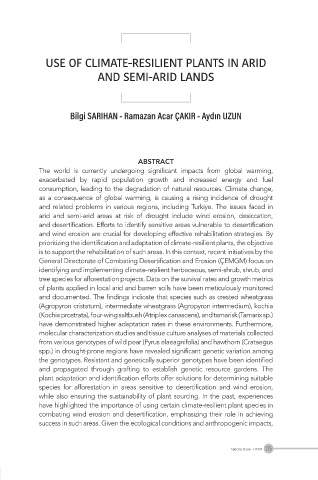Page 188 - Çevre Şehir ve İklim Dergisi İngilizce - Özel Sayı
P. 188
USE OF CLIMATE-RESILIENT PLANTS IN ARID
AND SEMI-ARID LANDS
Bilgi SARIHAN - Ramazan Acar ÇAKIR - Aydın UZUN
ABSTRACT
The world is currently undergoing significant impacts from global warming,
exacerbated by rapid population growth and increased energy and fuel
consumption, leading to the degradation of natural resources. Climate change,
as a consequence of global warming, is causing a rising incidence of drought
and related problems in various regions, including Turkiye. The issues faced in
arid and semi-arid areas at risk of drought include wind erosion, desiccation,
and desertification. Efforts to identify sensitive areas vulnerable to desertification
and wind erosion are crucial for developing effective rehabilitation strategies. By
prioritizing the identification and adaptation of climate-resilient plants, the objective
is to support the rehabilitation of such areas. In this context, recent initiatives by the
General Directorate of Combating Desertification and Erosion (ÇEMGM) focus on
identifying and implementing climate-resilient herbaceous, semi-shrub, shrub, and
tree species for afforestation projects. Data on the survival rates and growth metrics
of plants applied in local arid and barren soils have been meticulously monitored
and documented. The findings indicate that species such as crested wheatgrass
(Agropyron cristatum), intermediate wheatgrass (Agropyron intermedium), kochia
(Kochia prostrata), four-wing saltbush (Atriplex canascens), and tamarisk (Tamarix sp.)
have demonstrated higher adaptation rates in these environments. Furthermore,
molecular characterization studies and tissue culture analyses of materials collected
from various genotypes of wild pear (Pyrus elaeagnifolia) and hawthorn (Crataegus
spp.) in drought-prone regions have revealed significant genetic variation among
the genotypes. Resistant and genetically superior genotypes have been identified
and propagated through grafting to establish genetic resource gardens. The
plant adaptation and identification efforts offer solutions for determining suitable
species for afforestation in areas sensitive to desertification and wind erosion,
while also ensuring the sustainability of plant sourcing. In the past, experiences
have highlighted the importance of using certain climate-resilient plant species in
combating wind erosion and desertification, emphasizing their role in achieving
success in such areas. Given the ecological conditions and anthropogenic impacts,
175
Special Issue / 2024

